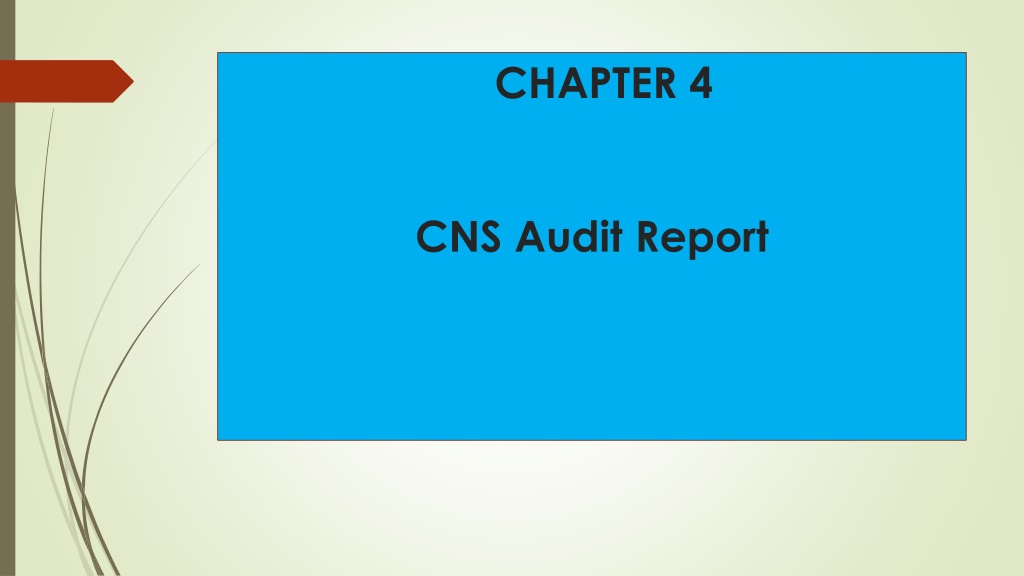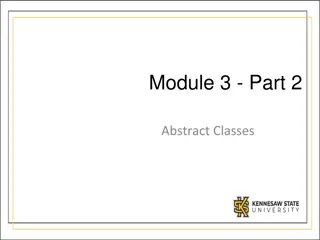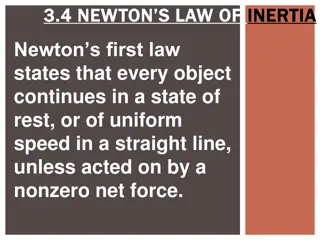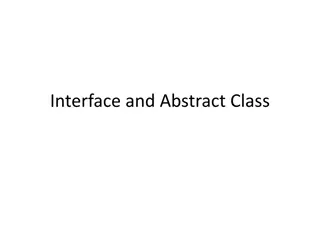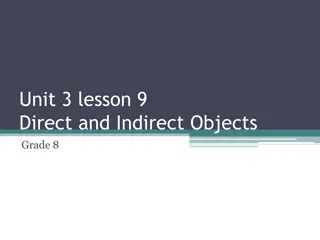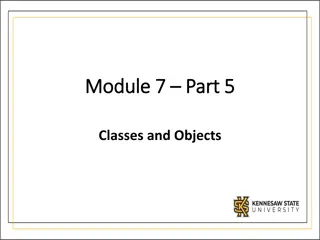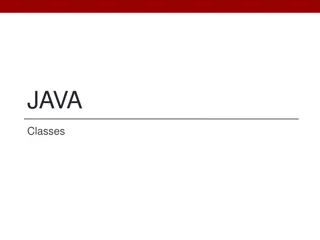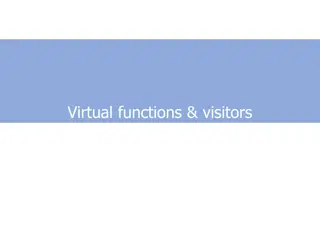Introduction to Classes and Objects
Classes and objects in Java are fundamental concepts in object-oriented programming. Understand the relationship between classes and objects, along with the declaration, attributes, and creation of objects. Explore the differences between instance and primitive variables to enhance your understanding of OOP principles.
Download Presentation

Please find below an Image/Link to download the presentation.
The content on the website is provided AS IS for your information and personal use only. It may not be sold, licensed, or shared on other websites without obtaining consent from the author. Download presentation by click this link. If you encounter any issues during the download, it is possible that the publisher has removed the file from their server.
E N D
Presentation Transcript
CHAPTER 4 CNS Audit Report
Objective Given a completed CNS checklist, write an Audit/Inspection report according to CAA audit reports templates.
Report-Definition Reports are documents produced to communicate specific information to an identifiable audience from an identifiable source
Audit Report An audit report is the formal representation of audit findings. The audit report is the end result of an audit and can be used as a tool for; requiring action, altering operations, enforcing accountability, or making decisions. An effective audit report is essential to making sure the results of your audit are presented in a way that is useful to the auditee and to ensure compliance. Before getting into the specifics of writing an audit report, it is important to understand the objective of the audit report. Having these in mind you should write a report that meets the objective it is supposed to.
Audit Report An audit report summarizes the results of an audit It gives a factual account of the audit Highlights observations made and if applicable recommendations An audit report is prepared by the team leader in coordination with team members It should be approved by the head of inspectorate (as applicable) before submission to the CNS provider.
Objective of Audit Reports 1. Illustrating non-conformities: The main goal of any audit report is to illustrate where the ANS-CNS provider does not conform with standards, rules, regulations or procedures that it is supposed to. It is important to clearly identify the non-conformity, as well as the standard the CNS provider does not conform with. It is then important to demonstrate which evidence you used to confirm the non-conformity. The goal is that each non-conformity will contain enough information so that the receivers of the audit report can rectify the non-conformance.
Objective of Audit Reports 2. Outlining positives: An audit report should not just include negatives. This is especially true for compliance reports, and operational audits. This allows the organization to focus on areas that are working and apply these to other areas. Example, if you are conducting an audit to evaluate if an CNS provider meets training requirements, you may say, "The audit revealed that the current training program meets or exceeds requirements". 3. Providing Opportunities for improvement: Beyond indicating things that are not conforming to requirements (non- conformities), it is important to also indicate high-risk areas, or areas that may be in compliance but are at risk of eventually not complying, or that could be improved.
Audit Report Provides an objective reflection of the audit exercise Details the audit process and summary of identified deficiencies Is written to make audit findings formal and request for corrective action by the audited CNS provider An audit report should be clear, concise and contain facts presented and agreed upon during the exit meeting
Qualities of a Good Audit Report An audit report should be objective and not contain: Subjective opinions Criticism Observations not discussed at the exit meeting Confidential information Trivial issues
Audit Report Writing Commences immediately after the exit meeting Before you commence writing your report, think about who will be reading the report and what is their scope of knowledge of the language you will use. An audit report is an official record of an audit, so it will likely be referred to in later years for review.
Audit Report - Contents The audit report should potentially include the following: Objectives What was audited, including the organization/area and scope Details of the auditee Audit team details Dates and locations of the audit Audit criteria used Audit findings (which may be summarized in the body of the report if they are reported separately elsewhere) Conclusions Improvement recommendations
Audit Report - Contents Other items may include: Audit plan People contacted within the auditee organization Audit process Problems encountered that may have an impact on the reliability of the results Achievement of the audit objectives Areas within the scope but not covered Follow-up plans and arrangements A confidentiality statement Distribution list for the audit report
Audit Report Other items may include: The audit report should outline the follow-up actions required to resolve any issues. The report should indicate the need for corrections or for corrective, preventive or improvement actions. These actions are usually decided and undertaken by the auditee within an agreed timeframe. The auditee should keep the person managing the audit programme and the audit team informed of the status of the actions. The auditor should ensure that remedial action is taken.
Audit Report (Findings) For each finding, there should be: A description of the non-compliance or observation Assigned risk rating of the non- compliance Timeframe for submission of actions for each non-compliance identified
Executive Summary This is an overview of the audit results. It should present overall conclusions and recommendations related to the Purpose and Scope Methodology. This section must include: a)A brief description of what was audited, objectives, scopes, and time periods. b)Statements of significant action plans. c) Overall statements of concerns and conclusions. d)Overall audit report rating.
Introduction/Background The Introduction details the following items: What was inspected; Why (the objective); Who was involved in the audit; Where (the scope); When (Date of audit); Method of inspection (Methodology).
Main Body Contains details of the audited/inspected areas including observations and findings When writing the body of the report, you need to understand the condition, criteria, cause, and effect. The findings of the audit report are reliant on these terms, and understanding and addressing them in each finding is key to a good report. a) Criteria is an explanation of the standards/requirement used to evaluate the service, program, function, or activity audited. b) Condition is how effectively CNS provider is complying. Requirements can either be fully, complied with, partially complied with, or not complied with. c) Cause is a statement on the reason things have gone well or poorly. Possibilities include inadequate procedures, procedures not being followed, poor supervision, or the CNS provider using unqualified personnel. d) Effect states the result of the conditions, in quantifiable terms. Is the effect increased risk or exposure? Is it poor performance? This should be addressed when you cover effect.
Audit Conclusions The audit report concludes against the audit objective and that the conclusion should be clearly indicated in the audit report. Contains results, evaluations and what action should be taken on the findings identified during the audit/inspection. These conclusions should be independent and factual, and not based on assumptions. A set of such conclusions leads to forming an opinion.
Recommendations (As applicable) Make effective recommendations. As an auditor/inspector, your final task is making recommendations for improvement for the audited CNS provider. Remember to do the following while writing your recommendations: a) Be positive. Focus on what is going right at the moment, and how the good aspects of the entity can be applied in ineffective areas. b) Be specific. Be very clear as to what specific aspects do not adhere to requirements, and to what concrete steps could be potentially implemented to ensure compliance. c) Identify who should act. Does the service provider need better employee performance or should management be picking up the pace? Make clear who needs to make changes. d) Keep recommendations brief. Be succinct - only include details that are necessary to your point.
Audit Report Appendices/Attachments Supporting materials. e.g. checklist, Corrective Action Request (CAR) form etc.
Audit Report Transmission Audit reports should follow a proper format. When polishing up the audit report, make sure to follow proper format before transmitting it. a) Include a cover page. The cover page should be three or four lines, and outline the subject of the audit report and the type of audit. b) A letter should follow the cover page. The memo should be one or two short paragraphs overviewing who and what was audited, who has received or is receiving the report, and plans for future distribution. c) A table of contents follows the memo, and it contains a catalogue of chapters, page numbers, sections, and suggestions of the audit. d) The report should be written in plainly-worded, non-technical language and use proper grammar and paragraph organization. e) Audit Reports are organized by chapters, each with a title, and by sections and subsections, each marked with a heading. Headings should go from general to more specific.
Audit/inspection report submission Once the team leader has assembled the global report, it will be forwarded to the head of inspectorate for approval. Timelines specified by the CAA will be followed in submission of the final report Handouts 4.1/4.1a
